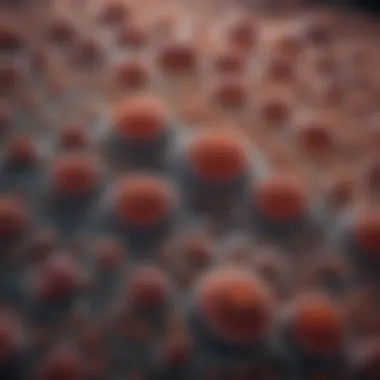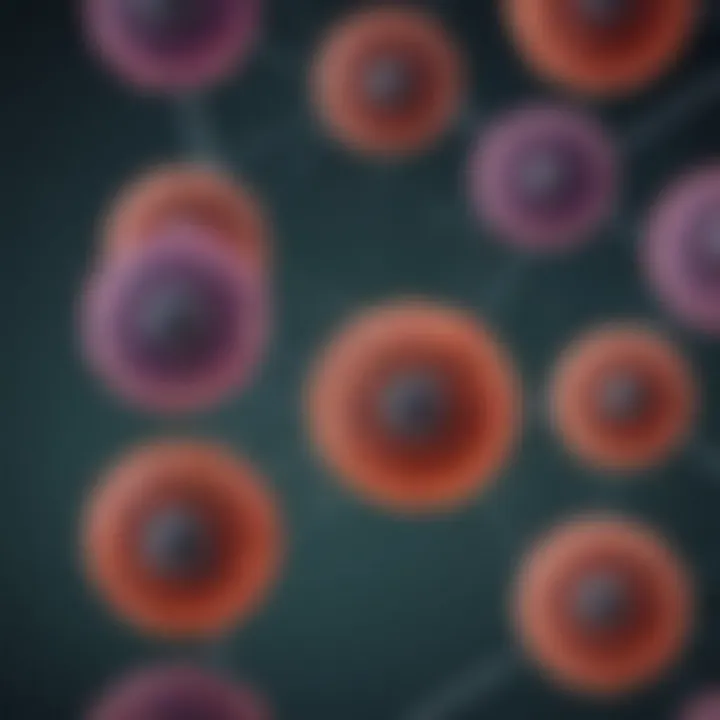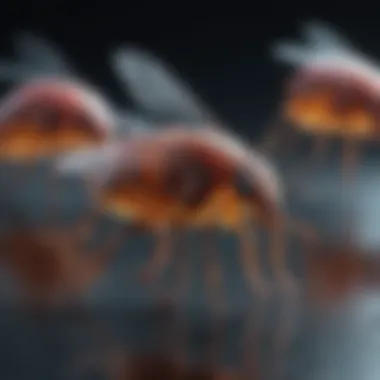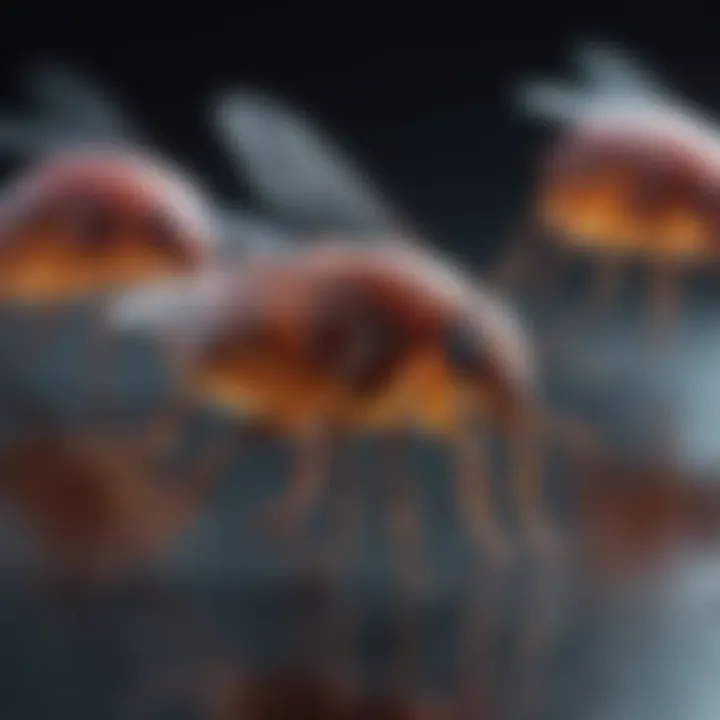Insect Cell Lines: Insights and Innovations in Biotechnology


Intro
Insect cell lines represent a critical component in modern biotechnology and molecular biology. Established from various species, these cell lines have garnered attention for their unique properties that offer substantial advantages in research and application. With the capacity for post-translational modifications similar to those of mammalian systems, insect cell lines facilitate the production of complex proteins and the exploration of gene expression in an efficient manner. Their robustness in culture and adaptability to high-density growth conditions make them favorites among researchers.
As the field of biotechnology continues to expand, understanding the nuances of insect cell lines becomes essential. This article aims to dissect their characteristics, delve into applications, and address methodological considerations crucial for effective utilization in laboratory settings. By unpacking recent technological advancements and their implications, we aim to illuminate the transformative role that insect cell lines play in both fundamental and applied science.
Research Highlights
Overview of Key Findings
Insect cell lines demonstrate distinct advantages over traditional cell lines, particularly regarding versatility in protein production and ease of genetic manipulation. In studies, it has been shown that:
- High Yield: Proteins expressed in insect cells often yield higher quantities compared to those from bacterial systems.
- Post-Translational Modifications: These cell lines can carry out essential post-translational modifications, which are critical for protein functionality in applications like therapeutics.
- Simplicity in Development: Establishing insect cell lines is often more straightforward than mammalian counterparts, allowing for rapid experimentation and development-driven research.
Additionally, advancements in transfection technologies have catalyzed increased efficacy in gene expression studies, facilitating an array of applications from vaccine development to the production of recombinant proteins.
Significance of the Research
The significance of research surrounding insect cell lines cannot be overstated. Not only do these findings bolster biopharmaceutical production, but they also provide a foundation for innovative solutions to global health challenges. The ability to produce vaccines, antibodies, and enzymes at scale positions insect cell lines as essential players in combating diseases that afflict both humans and animals. Their capacity to be mass-produced in bioreactors aligns perfectly with the growing demand for rapid production cycles in times of health crises.
Moreover, as researchers navigate the complexities of cellular behavior and function, insect cell lines offer a reliable system to study genetic elements without the extensive ethical considerations associated with vertebrate models. This elevates their relevance across various scientific disciplines.
"Insect cell culture technologies are revolutionizing the way we approach cellular research, opening doors that were previously locked by the limitations of other systems."
Original Research Articles
Summary of the Article
Numerous studies have explored the potential and efficacy of insect cell lines. A comprehensive understanding of these articles reveals consistent findings: increased efficiency in gene expression, enhanced yields of biopharmaceuticals, and the simplicity of culture methodologies. Each study contributes to the overarching narrative that insect cell lines indeed hold promise for the future of biotechnology.
Author Contributions
Leading researchers in the field have emphasized collaborative approaches, sharing insights that inform best practices for leveraging these cell lines in various applications. Through rigorous experimentation and data-sharing, the scientific community continues to uncover the breadth of insect cell line utilization.
Prelims to Insect Cell Lines
Invertebrates, especially insects, have become a cornerstone in the realm of biotechnology, particularly through the use of insect cell lines. These cell lines offer distinct advantages that traditional mammalian cells cannot achieve. The flexibility, cost-effectiveness, and rapid growth of insect cells make them ideal for various applications, including protein production and gene expression studies. Understanding insect cell lines is essential for researchers and professionals looking to optimize their biological studies and biopharmaceutical developments.
Definition and Overview
Insect cell lines are cultured cells derived from insects, primarily used for scientific research and biotechnological applications. Unlike mammalian cell lines, insect cells possess unique attributes, including the ability to undergo post-translational modifications similar to those in human cells, though there are some limitations. Commonly used insect cell lines include High-Five and SF-9. These cells have been integral in producing recombinant proteins, which are essential for vaccine development and therapeutic interventions.
Historical Background
The use of insect cells in research dates back to the 1980s. Early studies focused on the Baculovirus expression system, which utilized the capability of certain viruses to infect insect cells. This system has gained prominence due to its efficiency in producing large quantities of proteins. Notably, the first insect cell line, Spodoptera frugiperda (SF-9), was established during this period. Its development marked a significant leap forward, allowing scientists to harness the distinct benefits of insect cells in biopharmaceutical applications. Over the years, various enhancements in genetic engineering techniques have led to improved performance and functionalities of these cell lines.
Types of Insect Cell Lines
The examination of insect cell lines is crucial in biotechnological applications, expanding the understanding of how these cells operate under various conditions. Insect cell lines are particularly valued for their ability to produce complex proteins. They serve diverse roles in research and industry, from gene expression to vaccine development. Different types of insect cell lines, each with unique characteristics, contribute significantly to these processes.
High-Five Cell Line
High-Five cells, derived from the ovarian tissue of the Trichoplusia ni moth, are one of the most widely used insect cell lines. These cells are known for their suitability in large-scale protein production. One of the key advantages of the High-Five cell line is its ability to grow in suspension, which simplifies culture and scaling up production. Furthermore, they offer enhanced cellular growth rates and the potential for high yield. This makes them an ideal choice for researchers aiming to produce recombinant proteins and viruses.
The High-Five cell line is frequently utilized in baculovirus expression systems. This method effectively allows the incorporation of eukaryotic post-translational modifications, which can be essential for the stability and activity of proteins. Researchers often prefer this cell line due to its reliable performance in transient gene expression experiments.
SF-9 and SF-21 Cell Lines
SF-9 and SF-21 are two additional insect cell lines derived from the same Spodoptera moth species. SF-9 cells are established from a larval culture, while SF-21 cells were isolated from pupal tissue. Both lines are commonly used in laboratory settings due to their higher resistance to viral infection and enhanced growth characteristics.


These cell lines typically exhibit a serum-free growth potential, making them cost-effective and appropriate for industrial applications. They are often employed in gene expression studies, as they can support high levels of recombinant protein synthesis. Moreover, both cell lines have been instrumental in the development of baculovirus vectors that efficiently express foreign genes. Their adaptability in culture conditions makes them versatile tools for various biotechnological pursuits.
Baculovirus-Infected Cell Lines
Baculovirus-infected cell lines stand out due to their unique ability to express large and complex eukaryotic proteins. The baculovirus system is notably efficient at transferring genetic material into insect cells, allowing for extensive protein expression. This method is especially effective for proteins that require extensive folding or modifications that typically occur in eukaryotic cells.
Using baculovirus-infected cell lines can result in higher quality proteins compared to other expression systems. However, challenges still exist in scaling up production and achieving consistent results. The efficiency of this system largely depends on optimizing infection protocols, which is a critical aspect for researchers.
In summary, understanding these various insect cell lines is essential for selecting the appropriate system based on specific research needs. The comparative benefits observed in High-Five, SF-9, SF-21, and baculovirus-infected cell lines reflect their roles as powerful tools in molecular biology and biotechnology.
Advantages of Insect Cell Lines
Insect cell lines provide numerous advantages in the fields of biotechnology and molecular biology. These benefits make them suitable for various applications, especially in protein production and gene expression studies. The unique characteristics of insect cells distinguish them from mammalian and bacterial cell lines, offering specific advantages that warrant exploration.
Post-Translational Modifications
One of the fundamental advantages of insect cell lines is their ability to perform post-translational modifications. These modifications are critical for the functionality of many proteins, particularly glycosylation, phosphorylation, and lipidation. Insect cells, particularly those derived from the Spodoptera frugiperda moth, can add complex sugar moieties to proteins in a manner similar to mammalian cells. This capability is essential for creating biologically active recombinant proteins, such as therapeutic antibodies.
However, the glycosylation patterns differ from those of mammalian cells, which can sometimes affect the efficacy of therapeutic products. Still, insect cells can produce proteins that are often more effective than those from bacterial systems. Research has demonstrated that glycoproteins produced in insect cells can maintain higher stability and activity, enhancing their potential for biopharmaceutical applications.
Cost-Effectiveness
Cost-effectiveness is another significant benefit of using insect cell lines. Culturing insect cells generally involves lower operational costs compared to mammalian cells. This reduction in cost can be attributed to several factors:
- Less stringent growth conditions: Insect cells can thrive in simpler media, which reduces both material costs and the complexity of the cultivation process.
- Higher yield per culture: Insect cell lines often produce higher amounts of protein in a shorter period, leading to increased productivity.
- Scalability: The ease of scaling up insect cell cultures makes it feasible for large-scale protein production, thus driving down costs per unit of product.
These factors contribute to a more accessible production model, especially for researchers and companies looking to develop cost-effective solutions in biopharmaceutical development.
Fast Growth Rates
Insect cell lines are known for their rapid growth rates, which is crucial when time-sensitive projects are involved. The fast proliferation rate allows researchers to reach confluency more quickly, enabling them to harvest target proteins sooner. For example, High-Five cell lines can double in number every 12 to 24 hours under optimal conditions. This rapid growth not only accelerates research timelines but also enhances productivity.
Furthermore, the lifecycle of insect cells enables continuous production strategies. This adaptability can be fully leveraged in high-throughput screening and large-scale production settings, providing an edge over traditional mammalian cell cultures.
"Insect cell lines are revolutionizing the way biopharmaceuticals are produced, offering a blend of efficiency and cost-effectiveness that is hard to replicate in other systems."
In summary, the advantages of insect cell lines — from their ability to perform essential post-translational modifications to their cost-effectiveness and fast growth rates — position them as a vital tool in modern biotechnology. As demand for recombinant proteins continues to rise, understanding these benefits is key for researchers and industry professionals alike.
Applications in Biotechnology
Biotechnology thrives on the ability to produce and manipulate biological materials for various applications. Insect cell lines play an increasingly significant role in this field, providing unique benefits and capabilities that enhance research and practical outcomes. Their importance spans several areas, particularly in protein expression, gene delivery systems, and vaccine development. By utilizing insect cell lines, researchers can achieve high levels of productivity, scalability, and efficiency.
Protein Expression Systems
Insect cell lines are widely used in protein expression systems. These systems utilize the baculovirus expression vector system, which allows the introduction of a gene of interest into the insect cells. The result is an efficient means of producing large quantities of recombinant proteins. The high yield of proteins from insect cells can surpass that of traditional mammalian cell lines due to several factors including metabolic advantages and robust protein processing capabilities.
Moreover, insect cells are capable of performing some eukaryotic post-translational modifications that might be lacking in bacterial systems, leading to properly folded and functional proteins. Proteins such as enzymes, antibodies, and others can be generated rapidly, meeting the growing demands of research and industry. This has implications for drug production, diagnostics, and therapeutic applications.
Gene Delivery and Transfection Studies
Insect cell lines have paved the way for advanced gene delivery and transfection studies. The baculovirus system, for instance, not only enables the expression of foreign genes but also facilitates efficient gene delivery into target cells. This is crucial for the study of gene function, the development of gene therapies, and for understanding disease mechanisms.
The transfection efficiency achievable with insect cell lines is notable. Studies indicate that baculoviruses can infect a wide range of cell types, making it versatile for various applications. This characteristic greatly assists in their design for intricate experiments in molecular biology, emphasizing the utility of insect cells in genetic analyses.
Vaccine Development
The potential use of insect cell lines in vaccine development is an emerging area of interest in biotechnology. Insect cells can express viral proteins that serve as vaccine candidates, providing an alternative to traditional methods. This is particularly relevant in creating subunit vaccines, where specific protein antigens are produced to elicit an immune response without using live pathogens.
The advantages of using insect cell lines for vaccine production include cost-effectiveness and reduced time frames. By producing vaccine components rapidly and in scalable amounts, health authorities can respond more effectively to emerging infectious diseases. Recent studies have shown encouraging results in the use of insect-derived vaccines, highlighting their effectiveness and safety.


"The utilization of insect cell lines represents a robust and adaptable framework for contemporary vaccine strategies, showcasing new avenues in vaccine research."
In summary, insect cell lines have established a prominent presence in biotechnology. Their applications in protein expression, gene delivery studies, and vaccine development underline their importance in advancing scientific understanding and public health initiatives. The exploration of these cell lines continues to unfold, promising exciting developments in various biotechnological domains.
Laboratory Techniques with Insect Cell Lines
Laboratory techniques involving insect cell lines are crucial for maximizing their potential in various scientific applications. Understanding these techniques helps researchers optimize conditions for cell growth, gene expression, and protein production. Thus, their relevance in biotechnological research cannot be understated. In this section, the focus will be on notable methods such as cell culture, baculovirus transfer, and transfection protocols, each contributing significantly to the capabilities of insect cell systems.
Cell Culture Methods
Cell culture is the foundation of any research involving insect cell lines. These methods allow scientists to maintain and manipulate the cells outside the organism in a controlled environment. The essential components of insect cell culture include selecting the right medium, appropriate temperature, and atmospheric conditions.
- Medium Selection: Commonly, a medium rich in nutrients, like Grace’s Insect Medium or SF-900, is used to support cell growth. Each medium enables optimal nutrition for the specific insect cell type being cultured.
- Temperature and Atmosphere: Insect cell lines typically thrive at temperatures ranging from 25°C to 28°C. Maintaining a stable atmosphere is crucial to avoid stress on the cells.
Besides, proper aseptic techniques minimize contamination risks, which can compromise the integrity of the experiments. Such controlled conditions ultimately enhance the reproducibility of results across different studies.
Baculovirus Transfer Methodology
Baculoviruses serve as effective tools for gene delivery in insect cell systems. Understanding the methodology behind baculovirus transfers is fundamental for achieving successful genetic modifications. This involves creating a recombinant baculovirus that carries the gene of interest. The process can be summarized as follows:
- Construction of Recombinant Virus: Cloning the gene of interest into a baculovirus vector is the first step. This typically involves using plasmid techniques.
- Infection of Cell Culture: Once the recombinant baculovirus is produced, it is used to infect cultured insect cells, such as SF-9 or High-Five cells. The infection allows the virus to integrate the foreign gene, driving its expression.
- Harvesting and Analysis: After a period of incubation, cells can be harvested for further analysis. Protein production levels can be evaluated using techniques like SDS-PAGE or Western blotting.
Baculovirus-based systems are known for their ability to produce complex proteins with proper post-translational modifications, a crucial aspect for many biopharmaceutical applications.
This methodology significantly contributes to the versatility of insect cell lines in producing recombinant proteins.
Transfection Protocols
Transfection refers to the introduction of foreign nucleic acids into cells, a technique often employed to express genes or produce proteins. In insect cell lines, transfection protocols must be tailored for optimal efficiency. Common methods include lipid-based transfection and electroporation.
- Lipid-Based Transfection: This involves using liposomes that encapsulate the nucleic acid. The liposomes help fuse with the cell membrane, allowing the genetic material to enter the cells. This method is generally efficient and results in low toxicity.
- Electroporation: An electrical field facilitates the temporary opening of pores in the cell membrane, allowing nucleic acids to enter. While effective, careful optimization is necessary to avoid cell death.
For both methods, validation of transfection success is vital. This can be achieved through reporter genes that produce measurable outputs, such as fluorescence or enzyme activity.
Challenges in Insect Cell Line Research
Research involving insect cell lines has gained much attention in the fields of biotechnology and molecular biology. However, this area is not without its hurdles. Understanding these challenges is critical for researchers who aim to optimize the use of insect cell lines in various applications. Below are some specific challenges that researchers face in insect cell line studies.
Limitations in Post-Translational Modifications
Insect cell lines, while advantageous, exhibit certain limitations in post-translational modifications. These modifications are crucial for the proper function of many proteins. Insects have different glycosylation patterns compared to mammalian cells. As a result, the proteins produced in insect cells may not undergo the same modifications as those expressed in mammalian systems. This can lead to functional discrepancies in therapeutic proteins or other biotechnologically relevant products. For example, the presence of specific sugar moieties can affect how a protein interacts with its receptor, thereby impacting its efficacy. Researchers must carefully consider these variations when designing their experiments and may need to employ strategies to optimize these modifications.
Vector Stability Issues
Vector stability remains another concern in the use of insect cell lines. Baculovirus vectors are commonly used to deliver genetic material into these cells. However, the stability of these vectors can fluctuate, leading to variations in expression levels of target proteins. This can have profound implications for experiments aimed at high-throughput screening or protein production. A vector that integrates into the host genome can often experience recombination events that affect gene expression over time. Researchers must then use rigorous stability assessments and optimization techniques to ensure consistent vector performance. Monitoring vector integrity can help alleviate some of these issues, but it requires additional resources and time.
Reproducibility Concerns
Reproducibility is a significant challenge in any field of research, and insect cell culture is no exception. Variations in cell culture methods, media formulations, or environmental conditions can lead to inconsistent results. Inconsistent results can hinder validation of experiments and complicate collaborative research efforts. Moreover, the lack of standard protocols for certain procedures may exacerbate these issues. Researchers are encouraged to document their methods in detail, share data transparently, and utilize controls extensively to bolster the reproducibility of their findings. Building a community approach around sharing successful methodologies could promote uniformity and reliability in future studies.
Recent Advancements in Insect Cell Culture
Recent advancements in insect cell culture have significantly enhanced their utility in biotechnology. As researchers seek more effective methods for protein production and gene expression, improvements in cell culture techniques and methodologies provide essential benefits. This section covers genetic engineering innovations, automated high-throughput screening systems, and novel media formulations. Each of these components plays a crucial role in optimizing the efficiency and effectiveness of insect cell cultures.
Genetic Engineering Innovations
The field of genetic engineering has propelled the capabilities of insect cell lines to unprecedented levels. Innovations in this area facilitate the precise manipulation of genetic material to enhance the yield and quality of proteins expressed. One prominent example includes the use of CRISPR-Cas9 technology, allowing for targeted gene editing within cell lines. This spurred a wave of applications to improve traits such as virus resistance, metabolic capabilities, and protein synthesis efficiencies.
Furthermore, advanced vectors are being developed to support the expression of complex proteins, which is often a challenge in traditional systems. These optimized approaches increase the versatility of insect cell lines, expanding their potential use in various research and industrial applications.


Automated Systems for High-Throughput Screening
The integration of automated systems represents a significant leap in the efficiency of insect cell culture. High-throughput screening allows researchers to rapidly evaluate multiple conditions, assessing the impact on cell growth and protein expression in a short time frame. Automation minimizes the manual labor involved in routine tasks, thus reducing the chance of human error while increasing reproducibility.
These systems also enable real-time monitoring of cell cultures, providing valuable data that can inform decision-making processes. This data-driven approach results in faster optimization cycles and a more streamlined workflow, which is essential for large-scale experiments.
Novel Media Formulations
The development of novel media formulations for insect cell culture is another area of advancement that deserves attention. Specialized media can enhance the growth rates of certain cell lines, while also maximizing the yield of desired proteins. Innovations in this field often involve tailoring nutrient compositions to meet the specific metabolic needs of the cell lines used.
Additional aspects include supplementing media with various growth factors or adjusting pH levels to create optimal conditions for cell proliferation. Recent research indicates that some formulations can significantly reduce costs and labor associated with media preparation, contributing to more sustainable culture practices.
"The enhancements in insect cell culture methodologies are not merely incremental. They represent a paradigm shift in how biological research and product development can be conducted efficiently."
In summary, recent advancements in insect cell culture techniques considerably enhance the toolset available to researchers and biotechnologists. From genetic engineering innovations to automated systems for high-throughput screening and novel media formulations, these developments emphasize the growing importance of insect cell lines in pharmaceutical and biotechnological applications.
Insect Cell Lines in Pharmaceutical Development
Insect cell lines play a significant role in pharmaceutical development, mainly due to their unique properties that make them suitable for the production and testing of biopharmaceuticals. These cell lines are increasingly utilized in the bioprocessing of proteins, vaccines, and enzymes, primarily because they can perform post-translational modifications similar to mammalian cells while being easier and cheaper to maintain. Moreover, they offer a platform that aligns well with the growing need for scalable production processes in pharmaceutical research and development.
Role in Biopharmaceuticals
The relevance of insect cell lines in biopharmaceuticals cannot be overstated. For instance, using the Baculovirus expression vector system, researchers can efficiently produce complex proteins that require glycosylation and proteolytic processing. This system utilizes Spodoptera frugiperda (SF) cells to manufacture various therapeutic proteins and recombinant vaccines, which reduces the overall time from development to market.
- Scalability: The insect cell system can be scaled up for large-scale production, allowing for higher yield outputs compared to other systems.
- Cost-Effectiveness: When compared to mammalian cell lines, the production costs in insect cells are significantly lower due to less stringent growth conditions.
- Safety: Using insect cell systems can reduce the risk of contamination with human pathogens.
The potential for insect cell lines extends beyond simple protein production. For example, their application in creating virus-like particles (VLPs) has shown promise in developing novel vaccines. These VLPs mimic viruses but lack viral genetic material, making them safe for immunization while triggering an immune response similar to that of a real infection.
Comparative Studies with Other Cell Lines
Conducting comparative studies between insect cell lines and other popular cell lines, such as CHO (Chinese Hamster Ovary) and HEK293 (Human Embryonic Kidney) cells, yields valuable insights into the advantages and limitations of each system.
- Product Quality: While mammalian cells often produce higher-quality glycoproteins, insect cells are adept at producing a wide range of proteins at a faster rate, albeit sometimes with different glycosylation patterns.
- Adaptability: Research indicates that insect cells can be less sensitive to culture conditions, providing a more forgiving environment for protein production.
- Regulatory Considerations: Insect cell lines, owing to their non-human origins, may face different regulatory challenges compared to mammalian systems, which are often subjected to stricter guidelines.
"The unique conditions inherent to insect cell lines contribute to a diverse array of product profiles, making them a compelling choice in biopharmaceuticals."
Future Perspectives on Insect Cell Lines
Insect cell lines are showing promising pathways for innovation in various scientific fields, particularly in biotechnology and pharmacology. Their adaptability, rapid growth rates, and effective expression of eukaryotic proteins place them in a unique position within the research community. The future of insect cell lines is likely to expand as researchers continue to explore their potential applications and integrate new technologies to enhance their utility.
Potential Applications in Synthetic Biology
Synthetic biology represents a frontier of scientific inquiry, combining biology with engineering principles. Insect cell lines can serve as effective platforms for engineering new biological systems due to their scalability and versatility. They are capable of producing complex biomolecules that can function in various applications, such as drug development and gene therapy.
- Bioproduction: Insect cell lines can be tailored to synthesize novel enzymes, biofuels, and pharmaceuticals. Their ability to perform post-translational modifications makes them suitable for producing proteins that require specific functions or stability.
- Metabolic Engineering: Altering the metabolic pathways within insect cells can enhance the production of desired metabolites. This could lead to improved yields of important compounds, such as organic acids and secondary metabolites, which are essential in pharmaceuticals.
- Biosensors: Using insect cells to develop biosensors can facilitate monitoring environmental changes or detecting specific biomolecules. Such applications might improve the diagnostics of diseases or track pollutant levels in ecosystems.
By harnessing these strengths, researchers can push the boundaries of what can be achieved through synthetic biology, utilizing insect cell lines for innovative solutions to complex challenges.
Integration with CRISPR Technology
The integration of CRISPR technology with insect cell lines holds transformative potential for genetic research and biotechnology. This gene-editing technology can enable precise modifications in the genome of insect cells, facilitating a range of applications.
- Gene Editing: By utilizing CRISPR-Cas9, scientists can induce specific changes in the DNA of insect cells. This offers new possibilities for customizing strains to produce proteins with enhanced properties, which can be advantageous in therapeutic development.
- Functional Genomics: CRISPR can be applied to dissect gene functions using insect cell lines. By knocking out specific genes, researchers can explore their contributions to various biological pathways and processes.
- Disease Modeling: The ability to edit genes with precision allows for the creation of insect cell models that mimic human diseases. This could accelerate drug discovery and testing processes in a system that closely resembles the human cellular environment.
"The power of CRISPR technology, when combined with insect cell lines, can redefine approaches in genetic manipulation and therapeutic development."
End
In the realm of biotechnology and molecular biology, insect cell lines play a pivotal role. Their adaptability and unique properties make them an invaluable tool for researchers and industry professionals. This article has illuminated various aspects of insect cell lines, from their defining characteristics to practical applications across numerous sectors. By comprehensively exploring these facets, we see the profound implications insect cell lines have for scientific research, particularly in protein expression and vaccine development.
The importance of insect cell lines primarily arises from their ability to perform post-translational modifications effectively. This capability ensures the production of complex proteins that mimic their native forms found in higher organisms. Moreover, the cost-effectiveness and rapid growth rates associated with these cell lines provide significant benefits. Researchers may achieve their objectives more efficiently, minimizing both time and resource investments.
Summary of Key Insights
- Adaptability: Insect cell lines can be tailored for various purposes, enhancing their utility in research settings.
- Post-Translational Modifications: The ability to perform complex modifications is crucial for the accurate production of proteins.
- Cost-Effectiveness: Utilizing these cell lines often results in lower operational costs compared to traditional mammalian systems.
- Rapid Proliferation: Faster growth times lead to quicker experimental results, greatly aiding the research process.
- Innovative Applications: Their role expands into critical areas such as synthetic biology and vaccine development, underscoring their significance.
In summary, the discourse on insect cell lines unveils their multifaceted contributions to both basic and applied sciences. As we progress, the continuous advancement in cell culture methodologies promises to further enhance their significance. Our understanding will grow, leading to even more innovative applications in the field.







